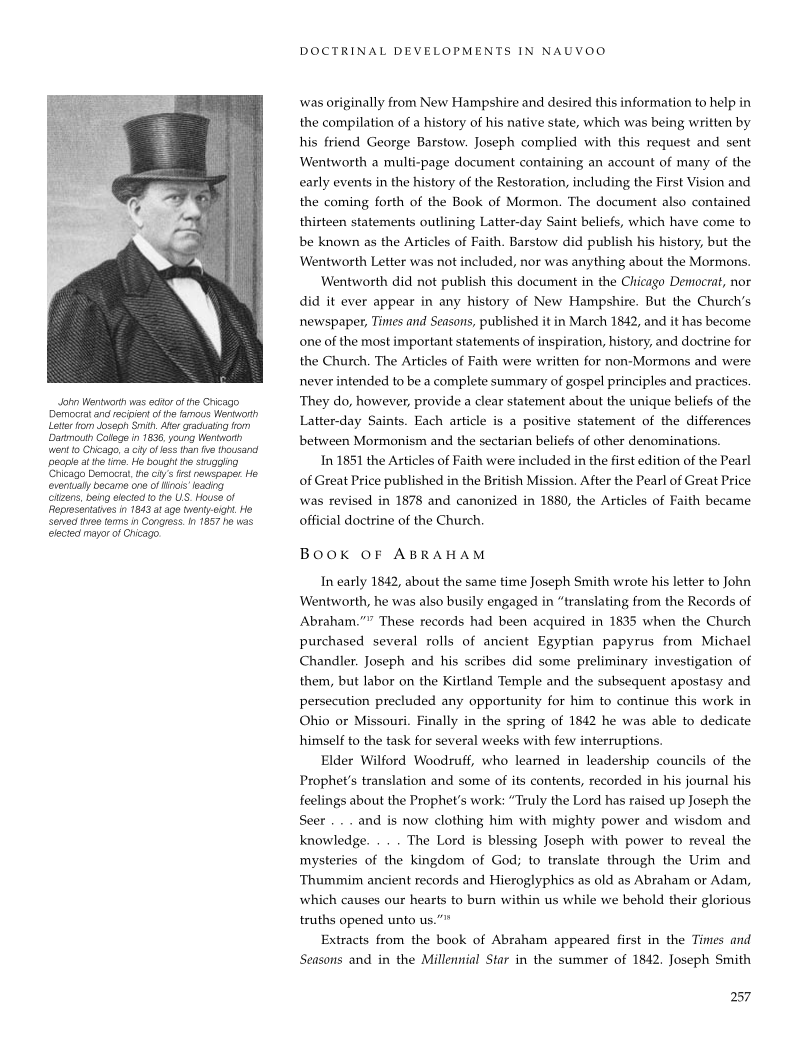CES manual discusses BOA translation.
- Type
- Book
- Source
- Church Educational System LDS
- Hearsay
- DirectSecondary
- Reference
Church History in the Fulness of Times: The History of The Church of Jesus Christ of Latter-day Saints, 2nd ed. (Salt Lake City, UT: The Church of Jesus Christ of Latter-day Saints, 2003), 257–258
- Scribe/Publisher
- The Church of Jesus Christ of Latter-day Saints
- People
- Aziz S. Atiya, John Wentworth, Wilford Woodruff, Michael Chandler, Joseph Smith, Jr., Church Educational System, The Church of Jesus Christ of Latter-day Saints
- Audience
- Latter-day Saints, Reading Public
- Transcription
BOOK OF ABRAHAM
In early 1842, about the same time Joseph Smith wrote his letter to John Wentworth, he was also busily engaged in “translating from the Records of Abraham.” These records had been acquired in 1835 when the Church purchased several rolls of ancient Egyptian papyrus from Michael Chandler. Joseph and his scribes did some preliminary investigation of them, but labor on the Kirtland Temple and the subsequent apostasy and persecution precluded any opportunity for him to continue this work in Ohio or Missouri. Finally in the spring of 1842 he was able to dedicate himself to the task for several weeks with few interruptions.
Elder Wilford Woodruff, who learned in leadership councils of the Prophet’s translation and some of its contents, recorded in his journal his feelings about the Prophet’s work: “Truly the Lord has raised up Joseph the Seer . . . and is now clothing him with mighty power and wisdom and knowledge. . . . The Lord is blessing Joseph with power to reveal the mysteries of the kingdom of God; to translate through the Urim and Thummim ancient records and Hieroglyphics as old as Abraham or Adam, which causes our hearts to burn within us while we behold their glorious truths opened unto us.”
Extracts from the book of Abraham appeared first in the Times and Seasons and in the Millennial Star in the summer of 1842. Joseph Smith indicated that more would be forthcoming, but he was unable to continue the translation after 1842. What the Church received—five chapters of the book of Abraham in the Pearl of Great Price—is only a portion of the original record.
In 1967 eleven fragments of the Joseph Smith papyri were rediscovered by Doctor Aziz S. Atiya, in the New York Metropolitan Museum of Art. Studies of them have confirmed that they are mainly ancient Egyptian funerary texts of the sort commonly buried with royalty and nobility and designed to guide them through their eternal journeyings. This has renewed the question about the connection between the records and the book of Abraham. Joseph Smith did not explain the method of translating the book of Abraham, just as he did not explain fully how the Book of Mormon was translated. Nevertheless, like the Book of Mormon, the book of Abraham is its own evidence that it came about through the gift and power of God.
- Citations in Mormonr Qnas
The B. H. Roberts Foundation is not owned by, operated by, or affiliated with the Church of Jesus Christ of Latter-day Saints.

